Inner Planets at Their Outer Range, and a Moonless Middle-night Hosts Halloween Treats!
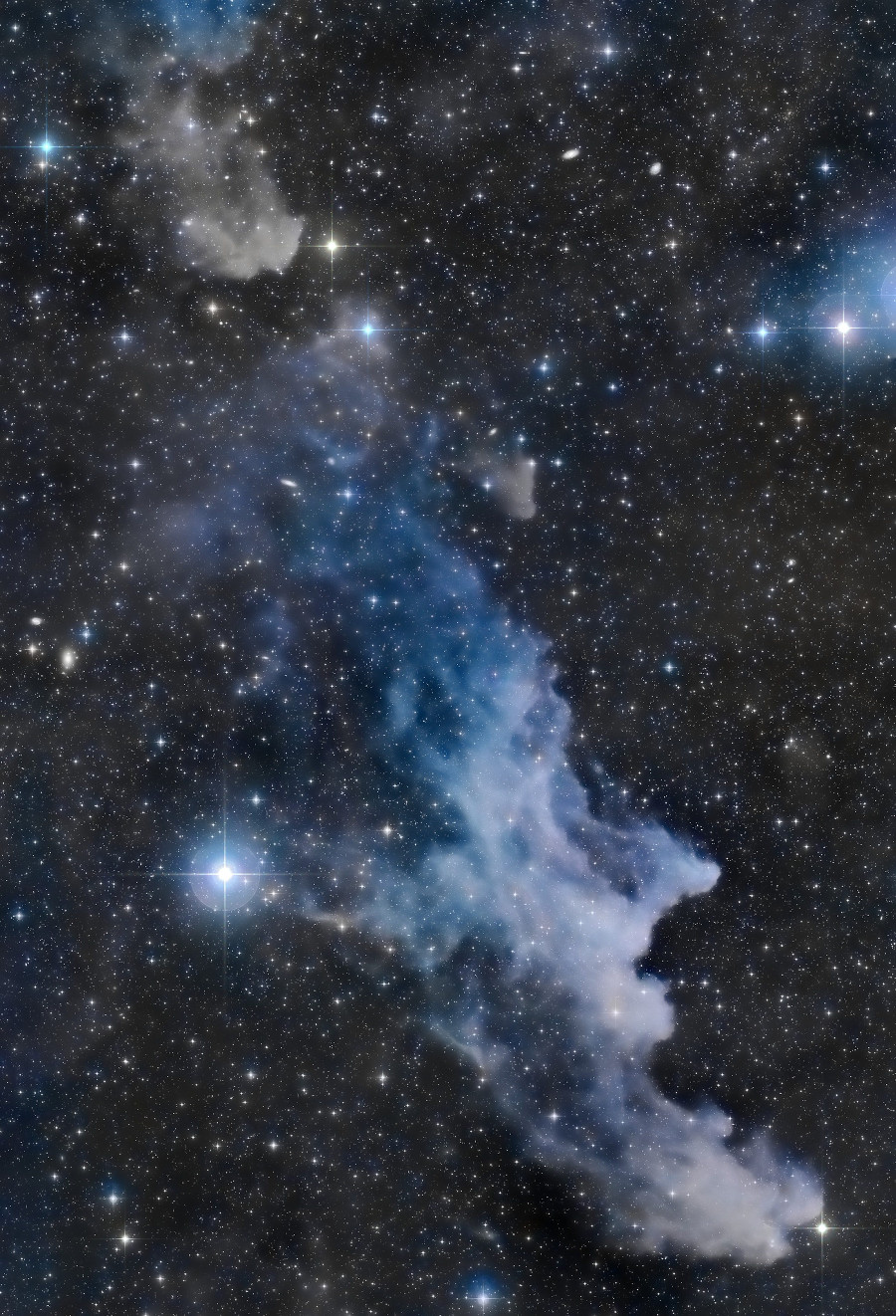
The faint Witch’s Head Nebula aka NGC 1909 and IC 2118, is a ghostly reflection nebula near the bright star Rigel in Orion. It’s very large – stretching nearly three finger widths from her chin to her forehead! Image by Jeff Signorelli, NASA APOD for Oct 30, 2015
Happy Halloween week, Stargazers!
Here are your Astronomy Skylights for the week of October 24th, 2021 by Chris Vaughan. Feel free to pass this along to your friends and send me your comments, questions, and suggested topics. You can also follow me on Twitter as @astrogeoguy! Unless otherwise noted, all times are expressed in Eastern Time. To subscribe to these emails please click this MailChimp link.
I can bring my Digital Starlab portable inflatable planetarium to your school or other daytime or evening event, or teach a session online. Contact me through AstroGeo.ca, and we’ll tour the Universe, or the Earth’s interior, together! My terrific new book with John A. Read entitled 110 Things to See With a Telescope is a guide to viewing the deep sky objects in the Messier List – for both beginners and seasoned astronomers. DM me to order a copy!
The moon will be waning the post-midnight sky worldwide this week and haunting morning skies – leaving our evenings nice and dark for viewing spooky Halloween treats, including some meteors! Meanwhile, Venus and Mercury each stretch wide of the sun, and Jupiter and Saturn shine in evening. Read on for your Skylights!
The Moon
The moon will spend the coming week lighting up the post-midnight sky and then haunting us in morning daylight, like a ghostly Halloween apparition.
Tonight (Sunday), after it climbs from its earthly crypt in mid-evening, the waning gibbous moon will shine between the horn-stars of Taurus (the Bull). Watch for it in the western half of the sky until noon on Monday. For the rest of the week, the moon will rise later and later and wane in illuminated phase while it decreases its angle from the morning sun.
On Monday and Tuesday night, the moon will traverse the stars of Gemini (the Twins). Monday’s moon will be positioned a finger’s width to the left (or 1 degree to the celestial northeast) of the large open star cluster named the Shoe-Buckle Cluster or Messier 35. The two objects will share the view in binoculars all night long – although the moon will move farther from the cluster hour by hour. To better see the cluster, which is nearly as wide as the moon, try hiding the moon just outside the left-hand edge of your binoculars’ field of view.
On Wednesday night, the now-crescent moon will pass a palm’s width above another even bigger star cluster, the Beehive Cluster or Messier 44, in Cancer (the Crab). To see the “bees”, centre your binoculars one binocular’s field width below the moon. Between midnight on Thursday and dawn on Friday, look for the moon shining a palm’s width to the lower left (or 5 degrees to the celestial east) of the Beehive.
The moon will officially reach its third quarter phase at 4:05 pm EDT, or 20:05 Greenwich Mean Time, on Thursday. (Moon phases occur independently of Earth’s rotation, so a particular phase can occur at any time of the day or night.) At third quarter our natural satellite always appears half-illuminated, on its western side – towards the pre-dawn sun. The name for this phase reflects the fact that the moon has completed three quarters of its orbit around Earth, measuring from the previous new moon.
After midnight on Friday, the horned crescent moon will depart the crab’s faint stars for the bright stars of Leo (the Lion). During the wee hours of Saturday morning, the moon will lunge at the heart of the lion, the star Al Jabhah aka Eta Leonis. The name Al Jabhah means “the Forehead” – but the star’s position above brighter Regulus, the lion’s body, and below Algieba, the base of the lion’s neck, suggests its heart, to me.
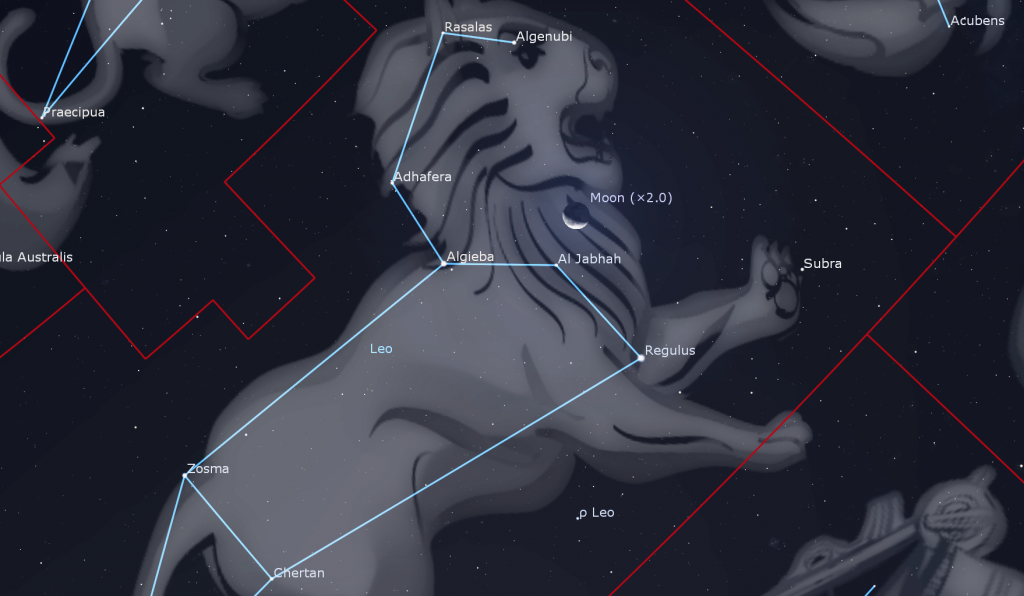
The moon won’t be visible on Halloween night this year. Last year it was full all night long! But if you get up early on Sunday morning, October 31, you will see its toothless smile glowing below the belly of the lion. Fear not! The moonless weekend will allow us to view some spooky deep sky objects. I’ll highlight some below.
The Planets
The two inner planets Venus and Mercury will each reach their greatest separation from the sun this week. That’s when they are easiest to see.
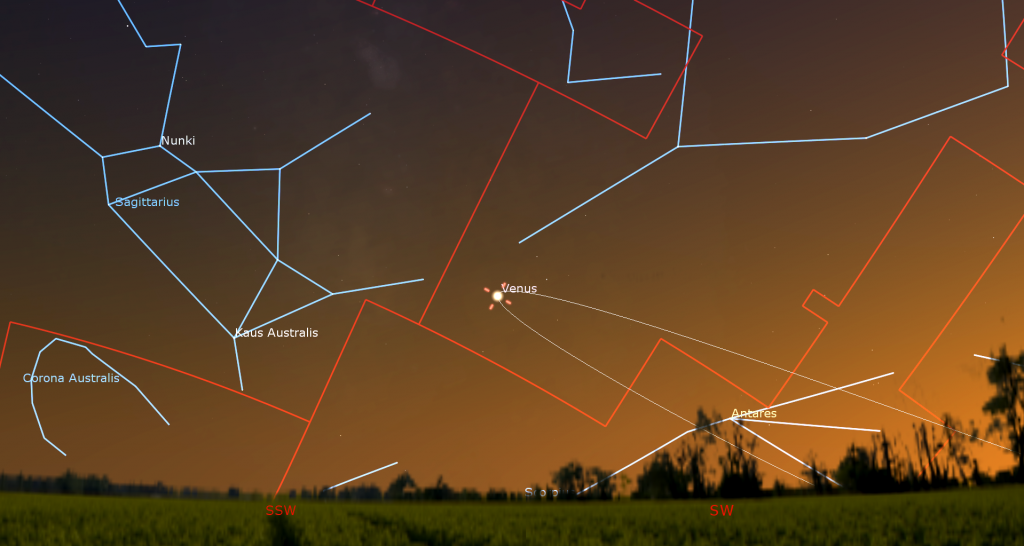
After many months in the western post-sunset sky, extremely bright Venus will reach greatest elongation, 47 degrees east of the sun, on Friday. Viewed in a telescope on Wednesday and Thursday, Venus will appear almost exactly half-illuminated, on its sun-facing side. Aim your telescope at Venus as soon as you can spot the planet in the sky (but ensure that the sun has completely disappeared first). That way, the planet will be higher and shining through less distorting atmosphere – giving you a clearer view of it. A brighter sky will also allow Venus’ shape to be seen more readily. The planet will grow in size and wane in phase every week for the rest of this year because Venus will be traveling into the space between Earth and the sun.
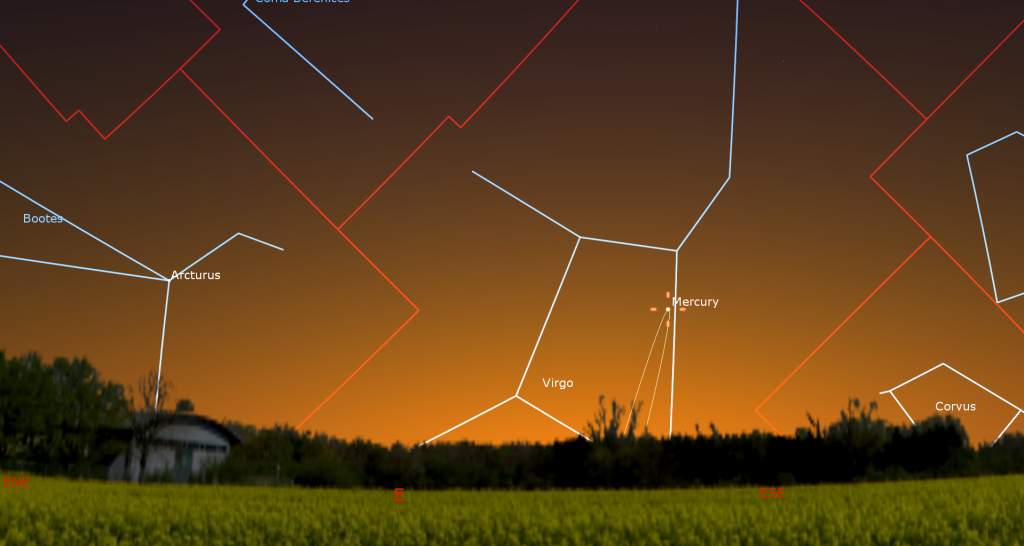
On Monday morning, the planet Mercury will reach its own maximum angle of 18 degrees from the sun, and peak visibility for its current morning apparition. Mercury’s position above the nearly upright morning ecliptic will make this an excellent apparition for Northern Hemisphere observers, but a poor one for anyone located near the Equator, and farther south. Mercury will be rising amongst the stars of in Virgo (the Maiden) shortly after 6 am local time this week, so look for the innermost planet shining brightly, very low in the east-southeastern sky between about 6:30 and 7:30 am. Don’t mistake the very bright star Arcturus, shining three fist diameters to Mercury’s left (or celestial northeast), for the speedy planet. In a telescope Mercury will exhibit a waxing gibbous phase, growing from 57%-lit on Monday to 78%-lit next Sunday morning. (For eye safety, be sure to put your optics away before the sun rises.) Reddish Mars will join Mercury in the morning sky in early November – commencing a year-long journey to a bright show at opposition in December, 2022.
Jupiter and Saturn will show up, relatively low in the southern sky, once the sky has darkened a little. Bright, white Jupiter’s dot will show up first, and then 18 times fainter (but still prominent), yellowish Saturn will join it, appearing 1.5 fist diameters to the right (or 15.5° to the celestial west). At around 8 pm local time, they’ll reach their highest elevation in the sky, over the southern horizon, and then they’ll set in the west in the hours after midnight.
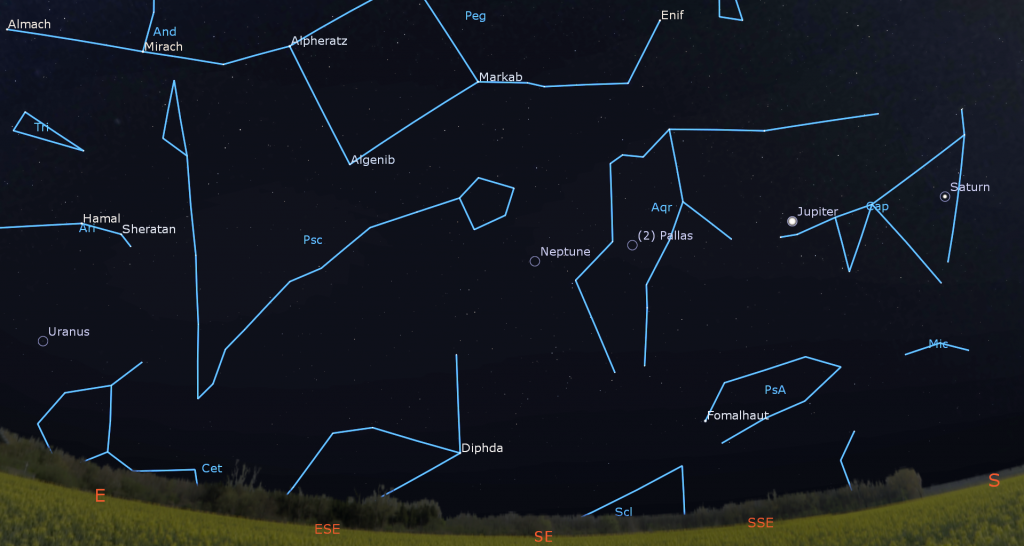
Jupiter and Saturn are both within the constellation of Capricornus (the Sea-Goat). Last week, Jupiter concluded a westward retrograde loop, which was a parallax effect produced by our changing vantage point on the faster-moving Earth. Now Earth is leaving them behind. For the rest of this year, both planets will be receding from us, and growing both less bright and smaller, day by day.
Binoculars and small telescopes will show you the Jupiter’s four large Galilean moons named Io, Europa, Callisto, and Ganymede. Since Jupiter’s axial tilt is a miniscule 3°, those moons always look like beads strung on a line that passes through the planet, and parallel to Jupiter’s dark equatorial belts. That line of moons, and the belts, tilt as Jupiter crosses the sky. The moons’ arrangement varies from night to night. Io, for example, orbits Jupiter once every 42 hours. From one night to the next night, 24 hours has elapsed on Earth – time for Io to complete half an orbit and shift from one side of Jupiter to the other. The other Galilean moons move less rapidly, taking between 3.5 and 16.7 days to orbit Jupiter.
For observers in the Eastern Time Zone with good telescopes, the Great Red Spot (or GRS) will be visible while it crosses Jupiter after dusk on Tuesday and Thursday, in mid-evening on Monday and Saturday, and around midnight on both Wednesday (with Io’s shadow) and Friday.
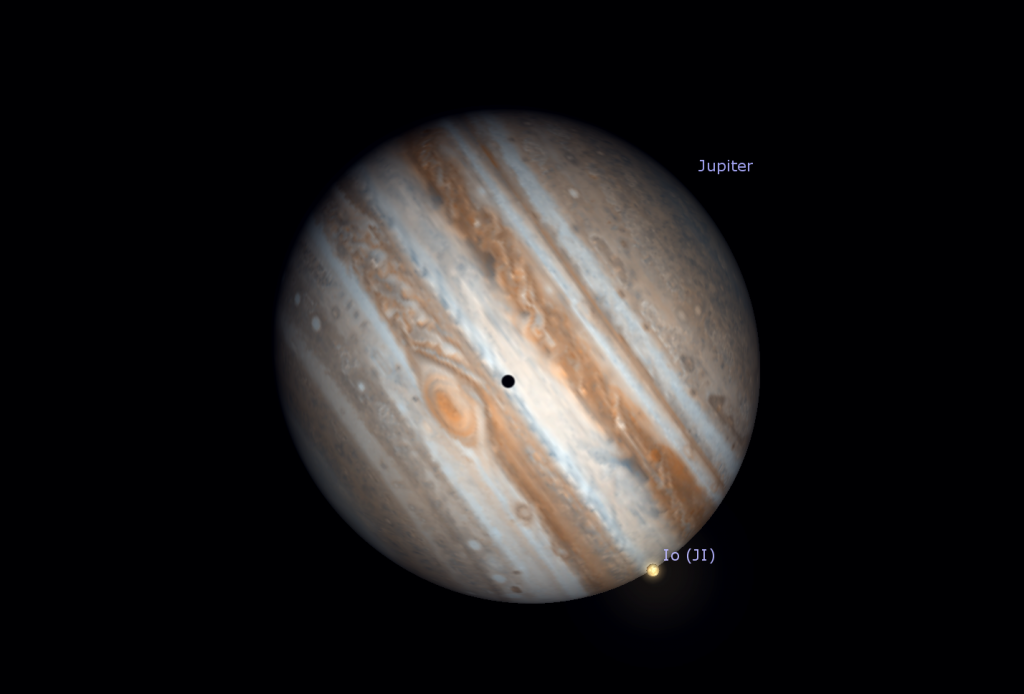
From time to time, the small, round, black shadows cast by Jupiter’s Galilean moons become visible in amateur telescopes when they cross (or transit) the planet’s disk. Starting late on Monday night, October 25, observers with telescopes from Alaska to Hawaii and across the Pacific Ocean can watch the small black shadows of two of Jupiter’s moons cross the planet’s disk at the same time. At 10:08 pm Hawaii Standard Time (or 08:08 UT on October 26), Io’s small shadow will join Ganymede’s larger shadow while it is already crossing. The two shadows will appear together for 2.5 hours. Meanwhile, Io’s more rapidly moving shadow will catch up to and overtake Ganymede’s shadow just before they both move off Jupiter at 12:22 am HST, or 10:22 UT. On Wednesday night, October 27 observers in the Eastern Time Zone can see Io’s small shadow cross Jupiter from 10:40 pm to 12:45 am EDT, accompanied by the Great Red Spot! And after dusk until 7:18 pm EDT on Friday, Io’s shadow will cross again.
Saturn and its beautiful rings are visible in any size of telescope. If your optics are sharp and the air is steady, try to see the Cassini Division, a narrow gap between the outer and inner rings, and a faint belt of dark clouds encircling the planet. Remember to take long, lingering looks through the eyepiece – so that you can catch moments of perfect atmospheric clarity.
From here on Earth, Saturn’s axial tilt of 26.7° lets us see the top of its ring plane, and allows its brighter moons to array themselves all around the planet. Saturn’s largest and brightest moon Titan never wanders more than five times the width of Saturn’s rings from the planet. The much fainter moon named Iapetus can stray up to twelve times the ring width. Iapetus is dark on one hemisphere and bright on the other, so it looks dimmer when it is east of Saturn, and it looks brighter when it is west of Saturn. Iapetus will reach minimum its brightness of magnitude 11.46 on Friday, October 29 and then it will double in brightness to magnitude 11.59 on December 8. The next brightest moons Rhea, Dione, Tethys, Enceladus, and Mimas all stay within one ring-width of Saturn.
During this week, Titan will migrate counter-clockwise around Saturn, moving from the left (celestial east) of Saturn tonight to the lower right (celestial west) of Saturn next Sunday. (Remember that your telescope will probably flip the view around.) How many of the moons can you see in your telescope?
The slow-moving, blue-green planet Uranus is spending this year parked below the two brightest stars of Aries (the Ram), Hamal and Sheratan, and about 1.6 fist diameters to the upper right (or 16 degrees to the celestial west-southwest) of the Pleiades star cluster. This week magnitude 5.7 Uranus will be observable all night long – especially after midnight, when it will have climbed more than halfway up the southeastern sky. Moonless skies will also help you to see the planet in binoculars, telescopes, and perhaps even your unaided eyes!
Distant, dim Neptune is in the sky all night long, near the border between Aquarius (the Water-Bearer) and western Pisces (the Fishes) – and nearly three fist diameters to the left (or celestial east) of Jupiter. Moonless skies will let you see the spooky, blue, outermost planet in binoculars and backyard telescopes. The main belt asteroid named (2) Pallas is not far away. This week, Pallas will be traveling downward (or southward) through Aquarius, about two finger widths to the right (celestial west of) the medium-bright star Hydor.
Halloween Treats
It’s time to seek out some spooky treats in honour of Halloween. Before we delve into the night sky, though, take a moment to look west after sunset and spot the bright, orange star Arcturus. During the week before Halloween, that star becomes the Ghost of the Summer Sun! That’s because its sits at the same altitude and azimuth in the sky that the sun did, exactly four months earlier at the same time of the evening!
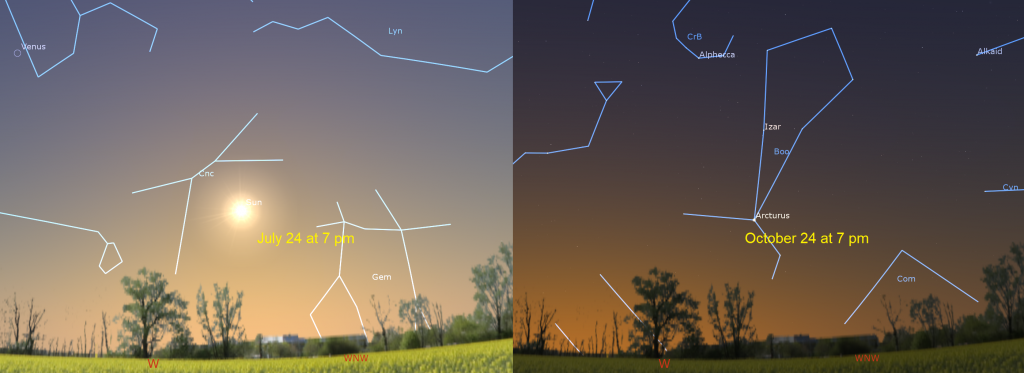
Two meteor showers will peak in November – but they’re already underway. The Southern Taurids shower and the Northern Taurids shower both arise when Earth travels through debris dropped by periodic comet 2P/Enke. The larger-than-average grain sizes of comet Enke’s particles often produce colourful Halloween fireballs!

The star Algol, also designated Beta Persei and the Demon Star, is among the most accessible variable stars for skywatchers. During a ten-hour period that repeats every 2 days, 20 hours, and 49 minutes, Algol’s visual brightness dims and re-brightens noticeably. This happens because a companion star orbiting nearly edge-on to Earth crosses in front of the much brighter main star, reducing the total light output we receive. Algol normally shines at magnitude 2.1, similar to the nearby star Almach (aka Gamma Andromedae). But while at minimum, Algol’s brightness of magnitude 3.4 is almost identical to Rho Persei (or Gorgonea Tertia or ρ Per), the star sitting just two finger widths to the lower right (or 2.25 degrees south) of Algol. The Demon Star will be at its faintest at 8:43 pm EDT on Thursday night, while about a third of the way up the eastern sky. It will be dim again at 5:32 pm EDT on Halloween night, but it won’t be visible, low in the northeastern sky, until twilight ends at about 7 pm.
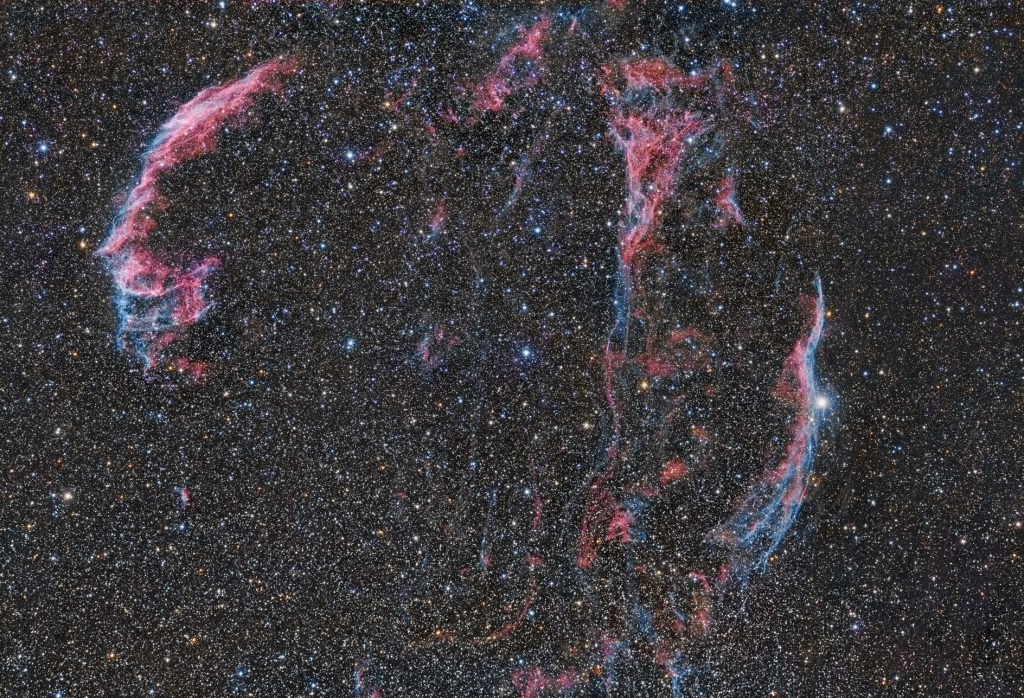
The bright, western arc of the giant Cygnus Loop, or Veil Nebula in Cygnus (the Swan), extends through a bright foreground star named 52 Cygni. It’s also nick-named the Witch’s Broom Nebula. Look for it below the left-hand wing of the swan, which sits high in the southwestern sky in evening. Lower in the western sky, in the right-hand wing of Aquila (the Eagle), owners of large telescopes can try for the Ghost of the Moon Nebula or NGC 6781. This large planetary nebula is a round, faint, ring nearly four times larger than the full moon!
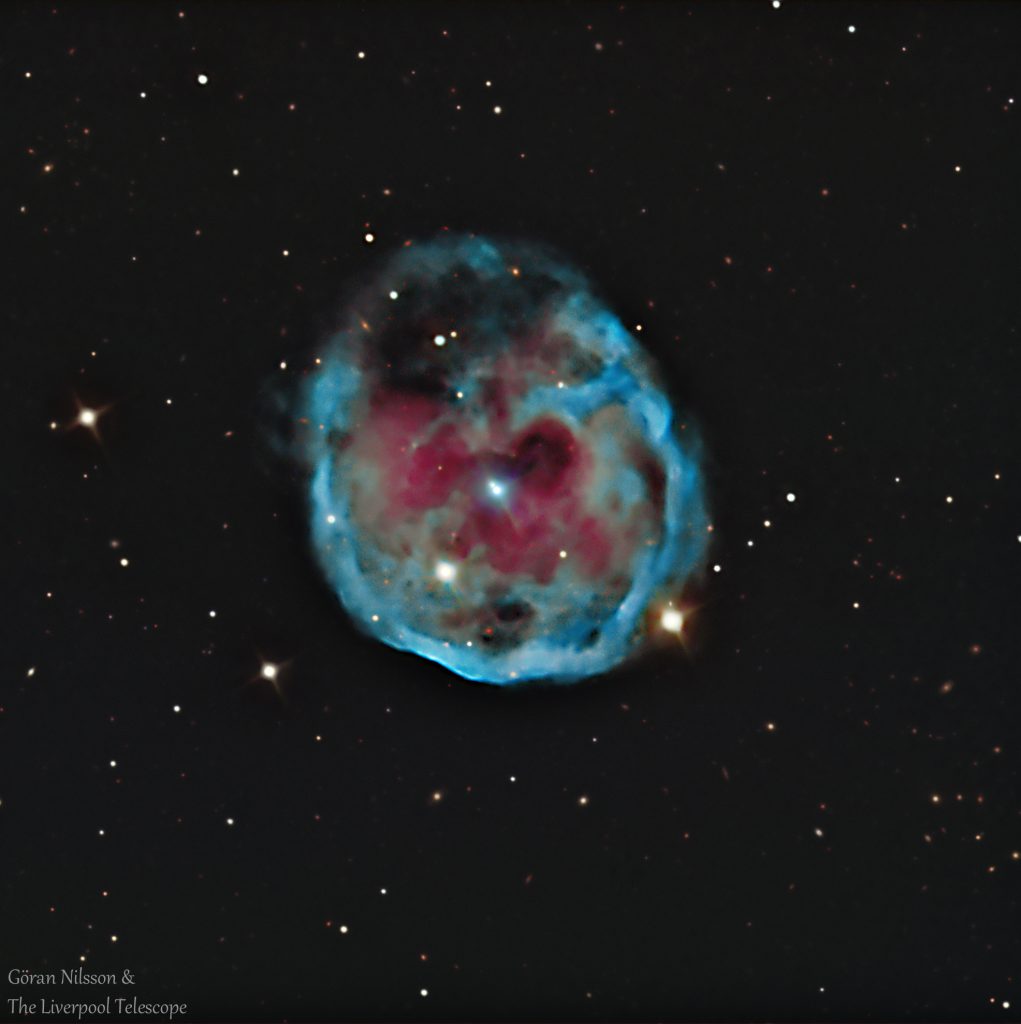
One of my favorite spooky objects can be seen in binoculars or a backyard telescope. It’s an open star cluster designated NGC 457 in W-shaped Cassiopeia (the Queen), but I prefer its common names – the Owl Cluster, ET Cluster, or Dragonfly Cluster. It consists of two prominent, brighter yellow stars that form the eyes, a sprinkling of dimmer stars forms the owl’s body and feet, and two curved chains of stars look like upswept wings. Be aware that the critter is positioned with its head pointing away from Cassiopeia. Locate the owl by taking the stars Navi and Ruchbah and making them the two vertices of a right-angle triangle. The cluster sits at the third vertex, where the 90 degree corner is. It’s about four finger widths above Ruchbah – as if the queen is bouncing a baby owl on her knee!

The Skull Nebula (also designated NGC 246) in Cetus (the Whale) is located in the southeastern sky in mid-evening. This planetary nebula’s oval shape and dark voids within it resemble a skull. For a challenge, try to spot Mirach’s Ghost (NGC 404), a magnitude 11.7 galaxy tucked just above the bright star Mirach in Andromeda (the Princess).
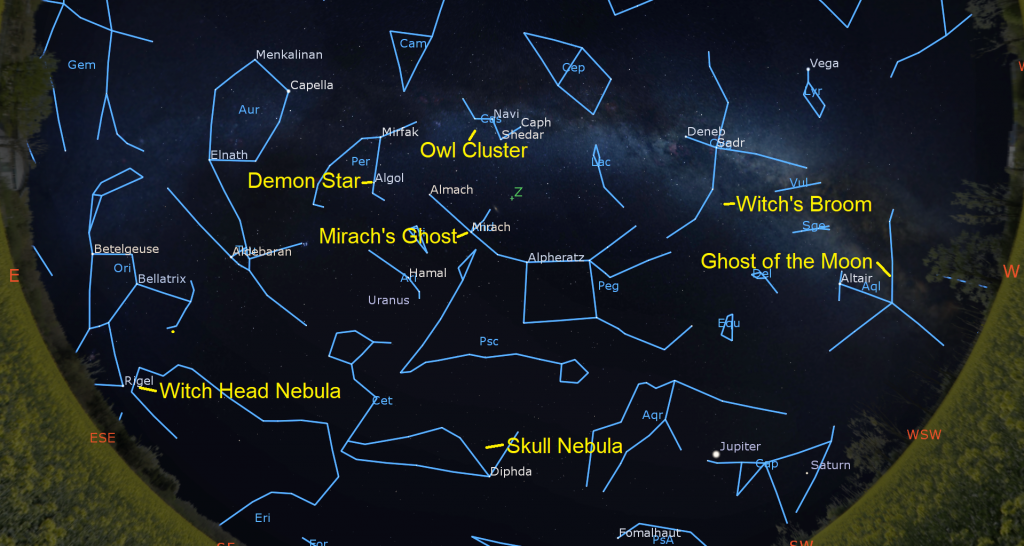
Night owls can try for the Witch Head Nebula (NGC 1909 and IC 2118), which will be rising after 10 pm local time this week. This object is actually a reflection nebula – the light from a bright is scattering off of the interstellar dust that it is embedded within – making the same type of blue we see in the sky in daytime. The object is large, too – it measures 3 finger widths high by 1 finger width across. It is centred 2.5 finger widths to the upper right (or to the celestial east) of the bright star Rigel in Orion (the Hunter). It’s a bit dim to see visually, so I’ve included a fantastic photograph in this post.
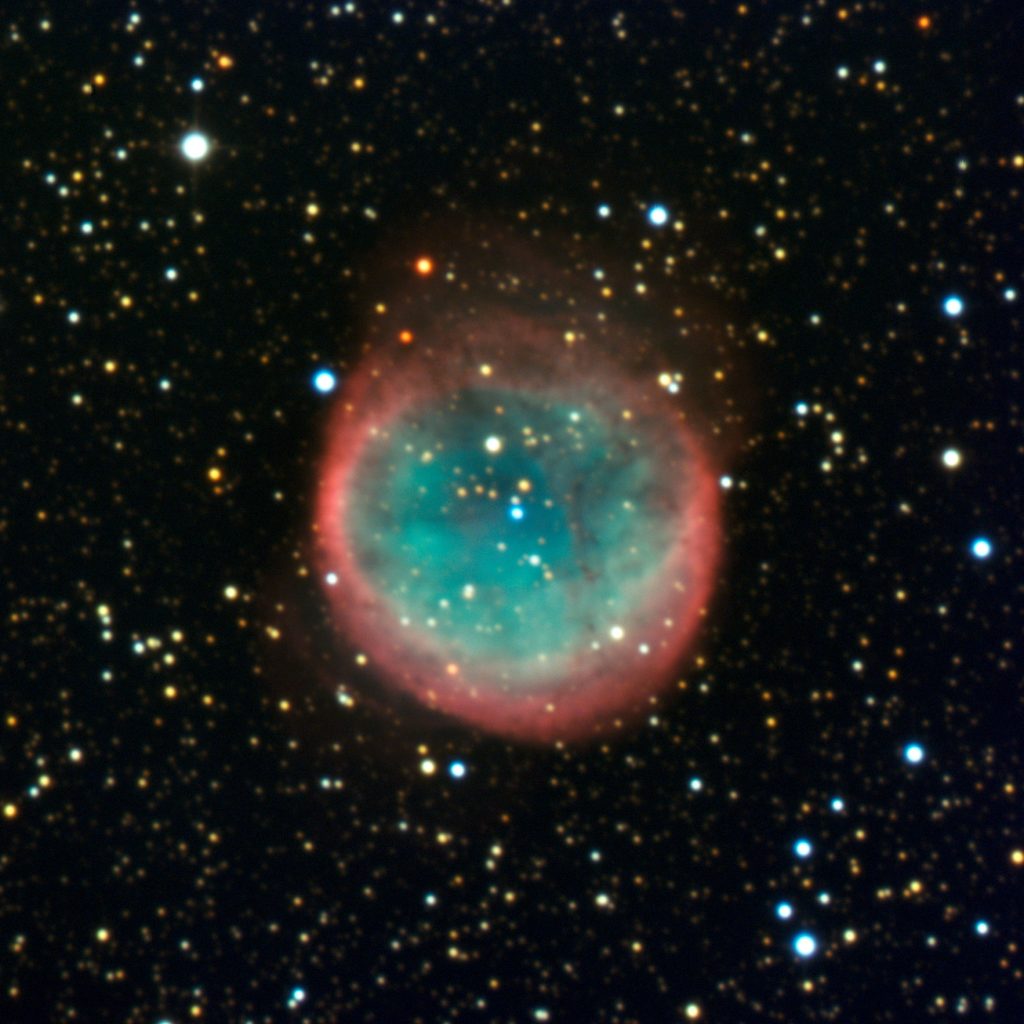
Orionids Meteor Shower
The annual Orionids Meteor Shower, derived from material left by repeated passages of Comet Halley, continues until November 14. Although we’re well past the peak night, this week’s moonless evenings will be good opportunities to spot some leftover Orionids. The meteors can appear anywhere in the sky, but will be moving in a direction away from a location (the radiant) above the bright red star Betelgeuse in the constellation of Orion (the Hunter).
Public Astro-Themed Events
Every Monday evening, York University’s Allan I. Carswell Observatory runs an online star party – broadcasting views from four telescopes/cameras, answering viewer questions, and taking requests! Details are here. Their in-person Wednesday night viewing has been converted to online via the observatory YouTube channel.
My free, family-friendly Insider’s Guide to the Galaxy webcasts with Jenna Hinds of RASC National returns on Tuesday, October 26 when we’ll cover autumn binoculars stargazing and spooky Halloween Targets! You can find more details and the schedule of future sessions here.
On Friday evening, October 29 at 5 pm EDT, U of T’s Astronomy & Space Exploration Society (ASX) will host a free public Zoom broadcast called Mapping the Milky Way in the Age of Gaia, about making new and improved maps of the stars in our galaxy. Details and the Zoom link are here.
On Friday night, October 29 at 6:30 pm EDT, the Ontario Science Centre will livestream a free public Family Trivia Night, with live views of the planets (weather permitting) and trivia questions. More information and the Zoom link are here.
On Friday evening, October 29 at 7:30 pm EDT, the RASC Mississauga Centre will live stream their Speakers Night meeting. This month will feature Dr. Michelle Thaller is an astrophysicist with over two decades of science communication experience. Her research involves the lifecycles of stars, and she has worked at the Jet Propulsion Laboratory, NASA Headquarters and the Goddard Space Flight Center, where she is currently the liaison between the Office of Communication and the Science Directorate. Her talk will discuss the deaths of stars. Black holes, supernovas, and neutron stars – Oh, my! Details are here.
Public sessions at the David Dunlap Observatory may not be running at the moment, but the RASC are pleased to offer some virtual experiences instead, in partnership with Richmond Hill. The modest fee supports RASC’s education and public outreach efforts at DDO.
On Friday night, October 29 from 8:30 to 9:00 pm EDT, the DDO Astronomers will stream Up in the Sky, with live views of celestial objects through the giant 74” telescope (weather permitting) and RASC members’ own equipment. There will also be a virtual tour of the DDO. Only one registration per household is required. Deadline to register for this program is Wednesday October 27, 2021 at 3 pm. The registration link is here.
Don’t forget to take advantage of the astronomy-themed YouTube videos posted by RASC Toronto Centre and RASC Canada.
Keep looking up, and enjoy the sky when you do. I love questions and requests. Send me some!